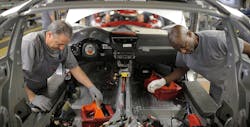U.S. Employment Seen Returning to Normal after Two Quirky Months
"If the July number is relatively normal, I think the conclusion that people will draw is that whatever July prints is more or less the new trend," said Stephen Stanley, chief economist at Amherst Pierpont Securities LLC in New York.
Stanley sees July payrolls rising by 170,000, compared with the Bloomberg survey consensus of 180,000. Job gains averaged 172,000 a month in the first half of this year.
The labor market has cooled from last year's breakneck pace as broader economic measures indicated the U.S. economy lost steam with consumers alone shouldering the load. Slower growth and firm but moderating job gains represent a challenge for Federal Reserve policy makers as they assess whether to raise interest rates this year.
Employers added a meager 11,000 workers in May, the fewest in almost six years. Payrolls rebounded by 287,000 in June, the most in eight months as hiring managers looked beyond turmoil in global financial markets.
Subdued Dismissals
Other indicators of the labor market are sending clear, positive signals. Jobless claims have held below 300,000 for 74 straight weeks—the longest stretch since 1973 and a level economists say is typically consistent with a healthy labor market. Job vacancies are hovering near 15-year highs, with just 1.4 unemployed workers for every available role.
The jobs report is also projected to show the unemployment rate fell to 4.8% after climbing to 4.9% in June as more people entered the labor force. As joblessness has reached the Fed's threshold for full employment, economists are anticipating the pace of payroll growth will slow further.
"The expansion is aging, we're hitting full employment," said Ryan Sweet, a senior economist at Moody's Analytics Inc. in West Chester, Pennsylvania. "Job gains will naturally decelerate, and we're in the early stages of seeing that play out."
Worker Pay
Wage growth remains a source of mystery, having been sluggish throughout the expansion even as joblessness dwindled. Average hourly earnings probably rose 0.2% in July from the prior month and 2.6% from 12 months earlier, according to the Bloomberg survey medians. The year-over-year reading would match June as the fastest rate of 2016.
A tightening labor market should prompt hiring managers to offer more pay to attract and retain skilled and experienced workers. Yet the process could still take a while, said Millan Mulraine, deputy head of U.S. research and strategy for TD Securities USA LLC in New York.
"The narrative of continued subdued wage pressure will remain," Mulraine said. "There still might be secondary slack that remains in the labor market, particularly as it relates to underemployment. That probably is one of the damping forces on wage growth."
Mulraine is looking at the gap between the underemployment rate and the headline unemployment rate, which is narrowing only very slowly. In addition to those who can't find work, the figures on underemployment also include part-timers who'd prefer full-time employment and those who've stopped looking, but would take a job if one were available.
- Michelle Jamrisko, Bloomberg
